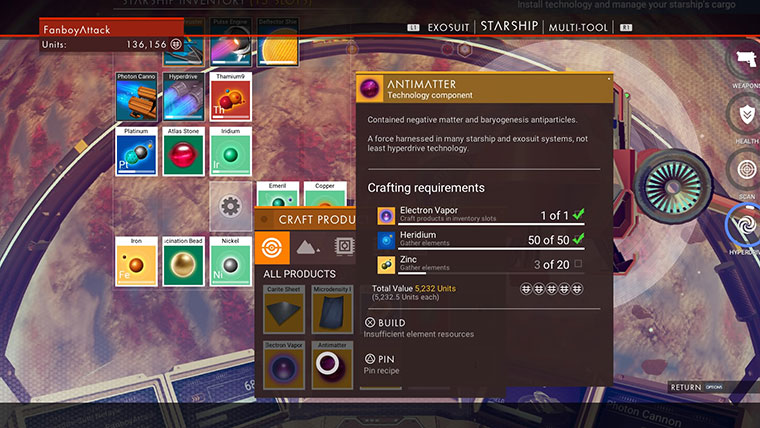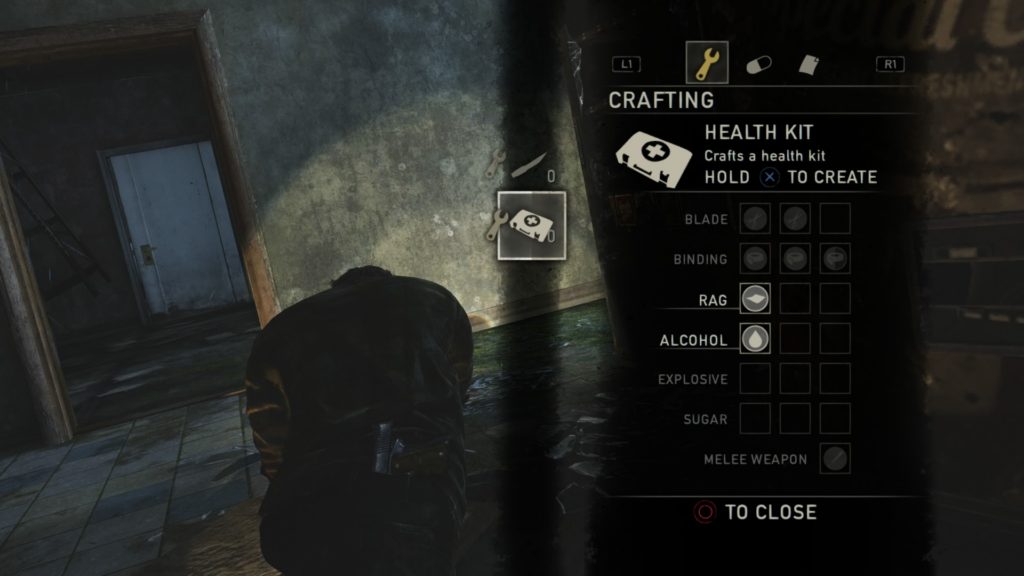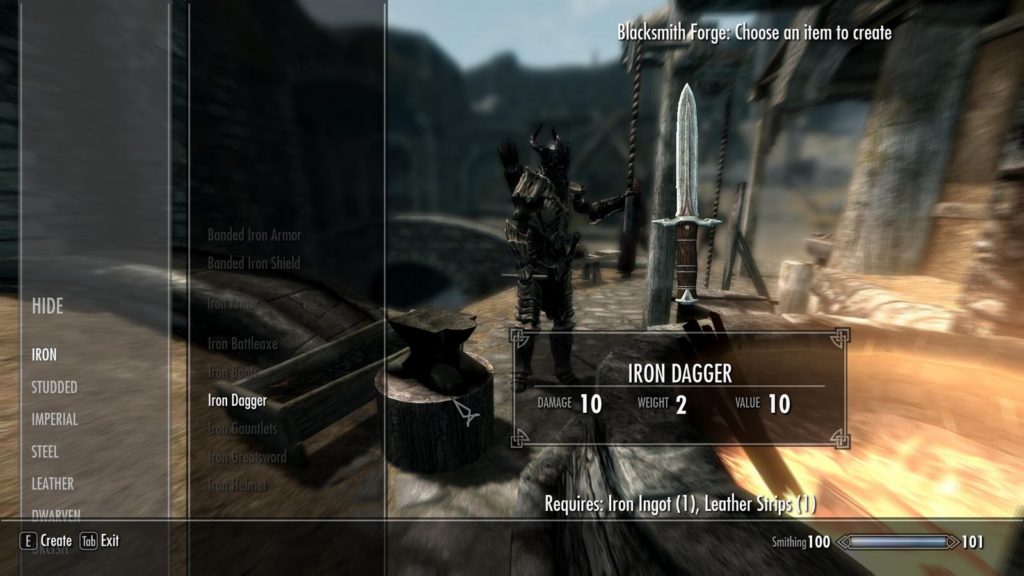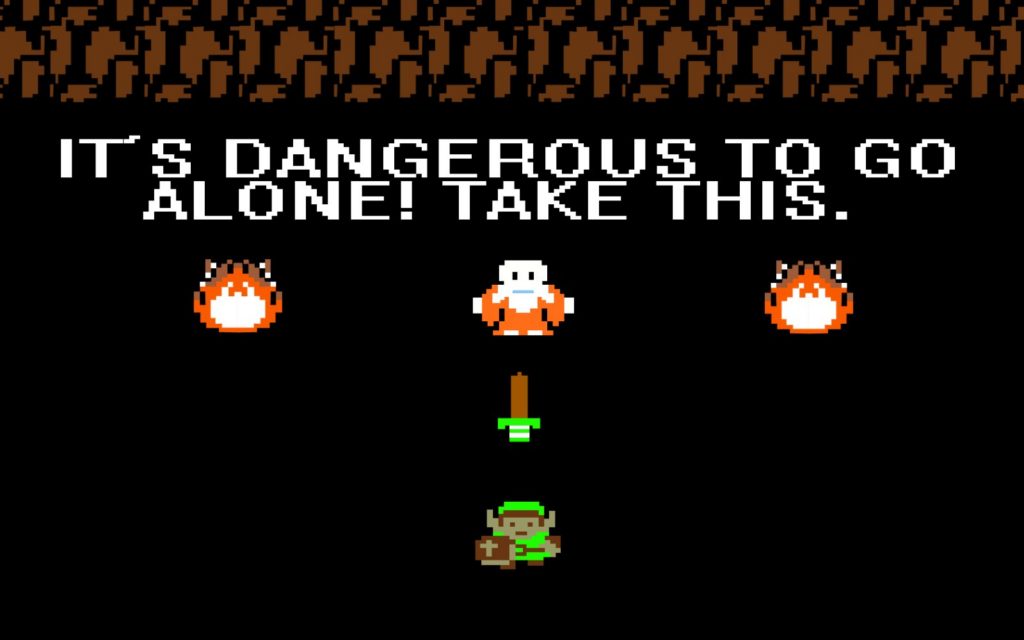Some videogames exist solely to allow us to make things: Minecraft (2009), LittleBigPlanet (2008), Super Mario Maker (2015). Many more games—too many more games—ask us to make things for no good reason. Crafting systems were once grafted-on additions to games already engorged with an excess of “features.” They have evolved; they have expanded; they have become sentient. They need to be stopped. This is a manifesto against them.
I. Crafting is boring, because it’s never more than a form of waiting
Crafting is spreadsheet management, data entry, Dilbert on a Monday as he looks for ways to use a stapler to kill himself. It requires no skill except recipe recollection (on the off chance that the recipe isn’t emblazoned prominently on the player’s HUD); it requires no resource except oceans of precious time, consumed in minute-sized chunks. It promises nothing except an exit from itself, holding better experiences at ransom. A videogame blacksmith is worse than any bridge troll.
Crafting is endless purgatory in No Man’s Sky: you have to craft everything, and craft constantly, before new horizons open to you, beckoning in their strangeness. Crafting turns Monster Hunter into my own personal hell. There are no levels to gain, no narrative developments to pursue. Besides monsters to hunt, there are only items to craft until you tire of crafting, or until they run out and must be crafted again.

Videogames always need ways to dilate themselves, to provide pacing between explosive moments: the long corridor before a boss fight; the panoramic silence before a brutal, agonistic descent. Crafting is not a good way to pause, precisely because it happens on the flat, dead plane of the pause screen, where materials like “iron ore” and “blue leaf” lie smugly in wait. It interrupts rather than interpolates, pulling you out of the rich sensory world of the diegesis and into a world of arbitrary, schematic abstraction.
People praise “deep” crafting systems as though being able to make 10,000 different versions of Leather Armor +1 were somehow inviting. These depths should be regarded with anxiety and terror.
II. Crafting is never about simulating actual craftsmanship
When was the last time you moved the control stick to carefully sand down the side of a canoe? When was the last time you released the trigger to align a needle and thread? When was the last time you felt any challenge—or satisfaction—in crafting itself, rather than the gathering of ingredients?
“Game design is a process of abstraction,” as Ian Bogost memorably put it. You can’t begrudge a game for abstracting a deeply material process that takes a lot of time into an incredibly immaterial—and immediate—virtualization. But everything that makes crafting crafting is not what crafting systems want to simulate. They’re not designed to make you feel like you’re making items; they’re designed to make you make items, to impede you ever-so-slightly with a middleman between “getting” and “using.” At their best they create tension: think of Joel in The Last of Us (2013), cobbling together a health pack—or, more literally, waiting for the bar to fill—in the middle of a room full of prowling zombies. But at their worst, and much more often, crafting systems create nothing except delay. They create a form of friction that is never physical, only temporal—never the feel of an object; only the feel of impediment.

There have been attempts to make crafting into ‘gameplay,’ introducing elements of risk, loss, timing, and skill into the process of making virtual items. This mostly happens in MMOs that want to make it possible to roleplay as an artisan. I remember the hardcore tanners, blacksmiths, and even cooks would spend whole days working the arcane systems of Final Fantasy XI (2002), hoping for better results under a full moon. In its worst—but still maybe more ambitious—incarnation, Final Fantasy XIV (2010) was designed to be a game, like Star Wars Galaxies (2003), where crafting and combat were equally complex and important experiences. Life is about making things as much as doing things, and there’s a lot of room for simulations of crafting in games that want to simulate life.
Most games don’t want to simulate life. And yet, they have crafting.
III. Crafting is a little bit satisfying, but that shouldn’t be enough
Finally collecting that one last elusive ingredient; hitting the ‘assemble’ button and seeing a new item pop into your inventory; hearing a canned sound, for the millionth time, that says you have something new—it all produces a dopamine rush. But it doesn’t produce wonder, fear, joy, sadness, anger. It doesn’t feel like a discovery, or a hard-won triumph, or a terrible mistake. It feels like an incremental, incidental nothing, like scratching an itch or eating a fry.

Some of us like to think that we pursue deeper, more complex pleasures than the nearly comatose Candy Crush-ers and Clash of Clan-ners at the airport. Crafting systems provide the same affective payoff—another completion; another checkbox—and beg the question of whether that payoff is the only thing we really want. Do we want games to make us feel things, to move us in complex and surprising ways, or do we want them to give us stuff to do?
Crafting systems turn one game into every other game; they are the faceless footsoldiers of a regime of homogeneity, a religion of systems. They turn play into the most deadening kind of work: the kind you neither rage against nor love with a passion; the kind you simply do, because it’s fine and it’s there.
IV. Where crafting is an attempt to simulate unalienated labor, it’s only more alienating
When Marx developed his theory of alienated labor in the 1840s, he was observing factory workers who had no emotional or existential connection to the things they made by the thousands, minute by minute, day by day. The problem hasn’t abated; if anything, it has intensified. We live in an age of infinitely-anonymous mass manufacturing and infinitely-obnoxious handicrafts—an age in which the production of most things is kept purposely out of view (e.g. Shenzhen), but the production of some things (e.g. handcrafted dog bowls made from repurposed pallet wood) is purposely in-your-face.
The controller in your hand is a commodity from nowhere. The videogame you play asks you to make a gun holster out of two humpback whale skins, because it’s the height of manliness not just to make your own shit out of animal parts, but to know where your upgrades come from. These two things, the reality and the fantasy, are deeply related. One begets the other. The problem is that making the holster is just another form of mass production, masquerading as meaningful labor. You have no attachment to that holster. Neither freedom nor necessity goes into the making of it; you do it because the game tells you to do it, as part of an endless and repetitive list of tasks.

The actual ‘making’ of that holster is obscured completely, placed beyond the frame of virtual experience, and the ingredients are completely arbitrary, determined from on high. “Humpback whale skin” could be “disco ball” for all you see of its actual shaping into gun-holster form—it could just as easily be “controller.” And all the feeling of individual self-actualization you might get from making it—this is my humpback-whale-skin holster, goddammit, and I made it from whales—is torpedoed from the beginning by the fact that there are so many more identical pirates out there, pressing A to make the holster happen. Games mass produce experiences that are supposed to feel singular: moments of heroism, of tenacity, of technocratic excellence. Nothing highlights this disjunction more than crafting.
V. Where crafting is an attempt to mimic survival, it only underscores our safety
There are two kinds of crafting systems in games: those that are geared toward excellence and those that are geared toward necessity. With the former, you craft because you want the best armor, weapons, consumables, etc. With the latter, you craft because crafting is the only way to stay alive in a harsh and commerce-less world. The former is common in RPGs; the latter is common in survival horror. And it must be said: the latter is never the most effective element of survival horror. In Resident Evil 4 (2005), you can make “Mixed Herbs” with various properties by combining herbs of different colors. This is not a source of tension. It’s a source of comfort, a way of giving the player a gift in a game already too generous with its items and upgrades.
“Displaced, neutralized, they are traces of a necessity that no longer need be met with forethought or ingenuity,” wrote the essayist Mark Greif in a polemic against exercise machines. He could just as easily have been describing crafting systems in videogames. They are the antithesis of dread and the enemy of the unknown, which too many games have abandoned in their pursuit of emotional regularity. When you reach a new planet in No Man’s Sky, you know hardly anything about it. But you know what you need to make. You begin to search, to scan, to collect, and the frenzy of activity transforms trepidation into comfort. Home is where the chores are.
VI. Crafting allows us to forget the dimensions of objects that have meaning
Objects are always embedded in contexts. They speak to the conditions of labor and class that produce them; they get transformed by the interpersonal webs they travel through; they are inscribed with memories and histories. A game itself can be meaningful precisely because of the baggage it carries around. Because of who gave it to you as a child, or who you played it with as an adult. Because of what happened in the background while you played it. Because it carries the essence of a different world within it, a home planet lost to time.
Items within games can have the same kind of weight. Uncharted is a series full of meaningless treasures, but Nathan Drake’s ring is something special—an heirloom, a burden, a link to the past. In a different way, no sword in Zelda is more significant than the sword you receive in the first Zelda, from an old man who simply says, “It’s dangerous to go alone! Take this.” The item is almost devoid of context—who is this guy, and why is he giving this sword to me? But it’s the only thing that comes between you and the unforgiving world. It becomes a kind of companion, as meaningful things always do.

Compare that to the Griffin Steel Sword you crafted from 1x Leather Scraps, 2x Steel Ingot, 1x Monster Brain, and 1x Monster Eye. Like all the other Griffin gear in The Witcher 3 (2015), it’s attached to the legend of an ancient hero, embedded in myth. But the fact that you have to craft it makes it all-too-ordinary. It becomes an assemblage of materials and stats, totally instrumental. It becomes a thing to throw away when you’re done with it, melted back down into virtual ingots. Crafting wants to give items meaningful context: this is a thing I “made” rather than a thing I found. But it only strips them naked.
VII. Crafting allows us to forget that games themselves are crafted
Like other, cuter attempts to mimic IRL textures and materials—Unraveled; Yoshi’s Woolly World (2015); LittleBigPlanet (2008); Kirby’s Epic Yarn (2010)—crafting betrays an anxiety about the virtuality of games in general. Those things are real. Games are not. Those things are authentic, handmade objects. Games are not. But games are always real, and it’s easy to forget that they’re also, always, objects. As Bogost has argued in his recent collection How to Talk About Videogames (2015), “We don’t watch or read games like we do cinema and novels and paintings, nor do we perform them like we might dance or football or Frisbee.” Games are aesthetic forms, but they are also “devices we operate.” It’s easy to forget their materiality largely because they contain things like crafting—because they feel like worlds rather than things.
Perhaps the only thing crafting has going for it is that it facilitates this amnesia: the universe of No Man’s Sky feels a bit more like a universe because you can take and make so many things within it. But what makes No Man’s Sky beguiling is that it’s a universe and an object at the same time. It’s a handmade experience despite the procedural generation of its terrain, and despite the crafting systems designed—always designed—to feel like another life. So many of its critics wanted the game to be “more” because the game itself invited, and still invites, expectations of totality. Crafting systems facilitate those expectations, and inevitably fail to meet them. They point at the inability of the game to have everything, to be a complete, livable world. They let us forget to treat the world as a piece of design, alive in its limitations as much as its expansiveness. They let us forget that the world of the game is a crafted object.
